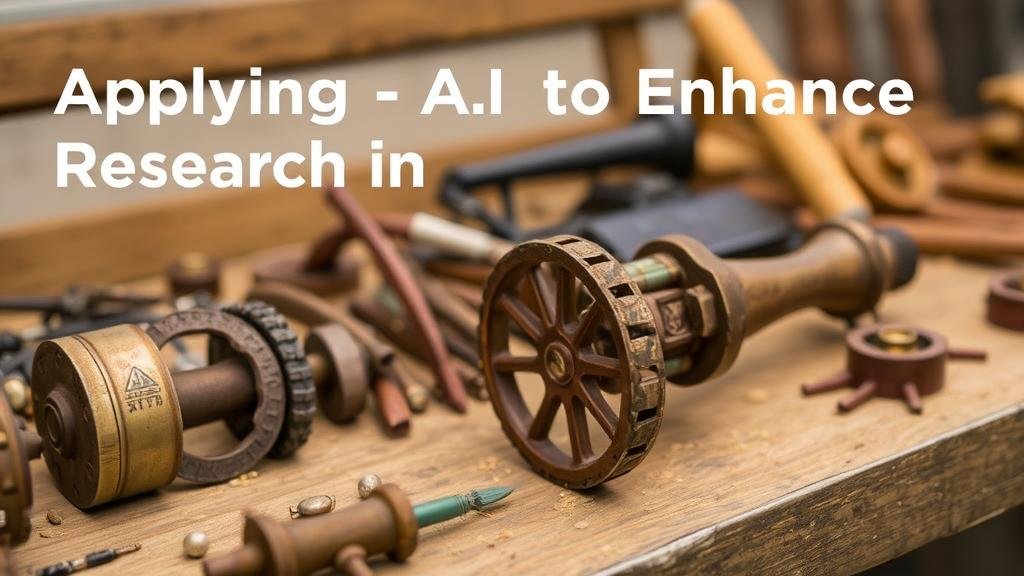Applying AI to Enhance Research in Historical Agricultural Tool Inventories
Applying AI to Enhance Research in Historical Agricultural Tool Inventories
The fields of agriculture and technology intersect in fascinating ways, particularly in the context of studying historical agricultural tools. This research investigates how Artificial Intelligence (AI) can improve the curation, analysis, and dissemination of historical agricultural tool inventories. By integrating AI technologies into agricultural history, we can uncover patterns, enhance data accuracy, and provide richer educational resources.
Introduction to Historical Agricultural Tools
Historical agricultural tools encompass a vast array of implements used throughout human history to aid in farming and food production. e tools can be categorized into various types based on their function and development over time, such as:
- Hand tools (e.g., hoes, sickles)
- Powered equipment (e.g., tractors, threshers)
- Innovative devices (e.g., seed drills, plows)
Understanding the evolution and usage of these tools provides insights into agricultural practices, socio-economic conditions, and technological advancements of different eras. For example, the transition from hand tools to mechanized equipment during the Industrial Revolution marked a significant change in productivity and rural labor dynamics.
The Role of AI in Data Collection and Management
Artificial Intelligence can streamline the process of collecting and managing data related to agricultural tools. Machine learning algorithms can analyze large datasets quickly, identifying trends and relationships that may not be apparent through traditional methods. For example, AI systems can be trained to recognize and catalog images of tools using computer vision techniques.
- In a study conducted by researchers at the University of California, they utilized AI algorithms to digitize and catalog over 1,500 historical farming tools, significantly reducing the time required for data entry and analysis.
- The use of natural language processing (NLP) allows researchers to sift through historical documents, extracting key information about the usage and distribution of these tools.
According to a 2023 report from the Food and Agriculture Organization (FAO), digitizing agricultural datasets can improve accessibility and preservation, especially in developing countries where historical records may be sparse.
Data Analysis and Interpretation Using AI
AI facilitates advanced data analysis by enabling researchers to uncover intricate patterns and correlations between tool usage and various agricultural practices. By employing predictive analytics, researchers can forecast the impacts of historical tools on contemporary agriculture, illustrating the continuity or changes in farming techniques.
- For example, a collaborative project between Northeastern University and the Smithsonian Institution used AI to analyze the relationship between specific tools and crop yields, leading to insights on optimal tool usage for various crops.
- Also, clustering algorithms can categorize tools based on geographical distribution, helping to identify regional agricultural practices and innovations.
Enhancing Educational Resources and Public Engagement
AI not only improves research strategies but also enhances educational outreach regarding agricultural history. Interactive platforms powered by AI can deliver educational content tailored to diverse audiences. e services can include:
- Virtual reality (VR) experiences that allow users to explore historical farms using various tools in simulated environments.
- AI-driven chatbots that provide information and answer questions regarding historical agricultural practices and tools.
For example, a project by the National Museum of Agriculture in the UK implemented an AI educational tool that introduced students to the concepts of agricultural evolution and technological milestones in farming history.
Challenges and Ethical Considerations
Despite the promising benefits of applying AI in this field, several challenges and ethical considerations arise. These include:
- Data quality and accuracy: The reliability of AI models hinges on the quality of input data. Historical tools may not always be well-documented or categorized.
- Access and equity: Ensuring that AI tools are accessible to researchers in both developed and developing regions is crucial to avoid widening the digital divide.
- Interpretation biases: AI models can inadvertently perpetuate biases present in the training data, leading to skewed interpretations.
Researchers must actively address these issues to harness the full potential of AI while promoting responsible scholarship.
Conclusion and Future Directions
Integrating AI into the study of historical agricultural tool inventories presents significant advantages, from improved data management to enhanced educational outreach. Continued research is needed to refine these technologies and address existing challenges. Future studies may focus on:
- Developing more inclusive datasets that reflect a broader range of cultural and historical contexts.
- Exploring interdisciplinary collaborations that combine agricultural history with computer science, data analytics, and public outreach.
By applying AI judiciously, we can further our understanding of agricultural history, fostering greater appreciation for the tools that shaped human civilization.



